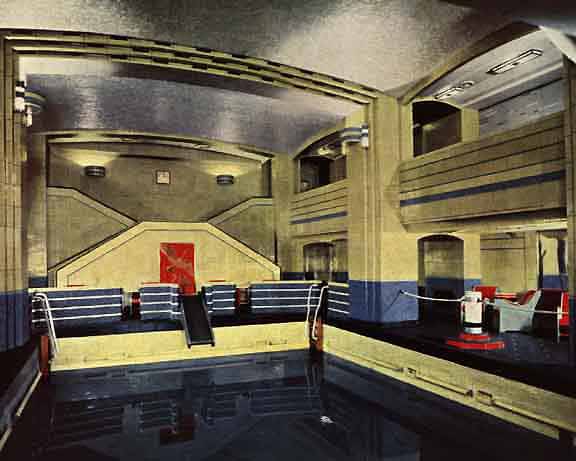
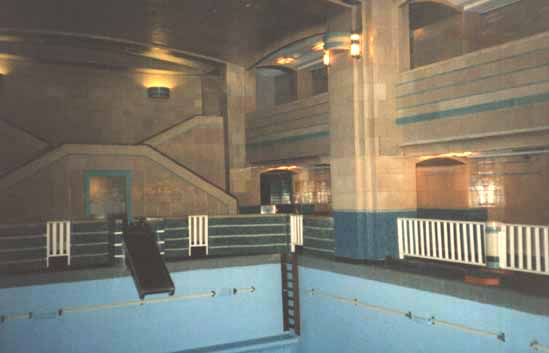


The 1st Class pool post-war, and today - empty, dark and disused
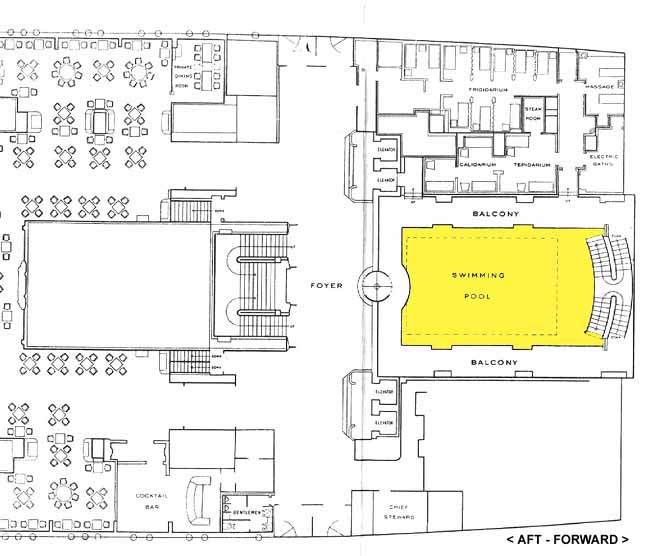
Location of the Pool showing post-war layout.
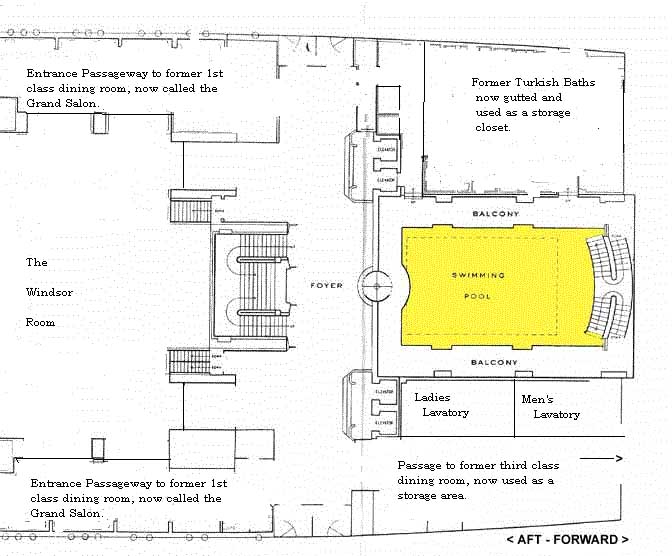
Layout today.
The First Class (called cabin class before World War 2) swimming pool is located amidships on current R and C decks (formerly called C and D decks). The two deck space includes a balcony surround with a graceful staircase descending to the pool basin level. The space in which the pool is set measures 60 ft in length by 42 ft in width, while the dimensions of the pool basin itself are 35 ft in length and 22 ft in width. The fore or deep end has a water depth of 6 ft. while the aft or shallow end has a water depth of 4 ft.
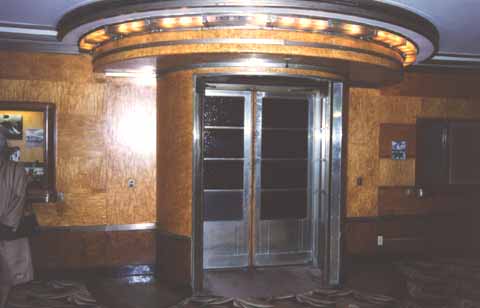
The entrance to the pool on R deck today.
Per the Shipbuilder:
"The colour scheme of the setting incorporates straw coloured faience, with bands
of emerald green and pillar-box red, and points of interest are provided by an illuminated
fountain and two ornamental drinking fountains. A feature of the scene is the lovely
effect of the mother-of-pearl ceiling.
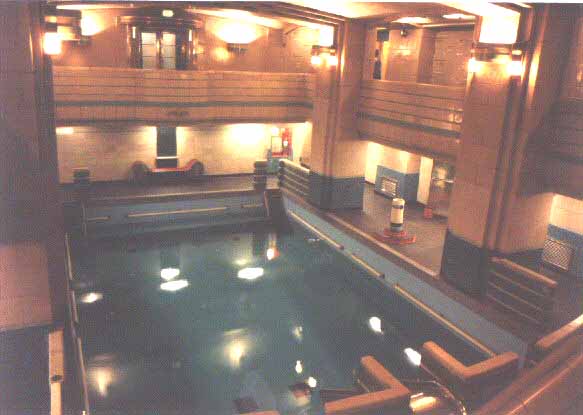
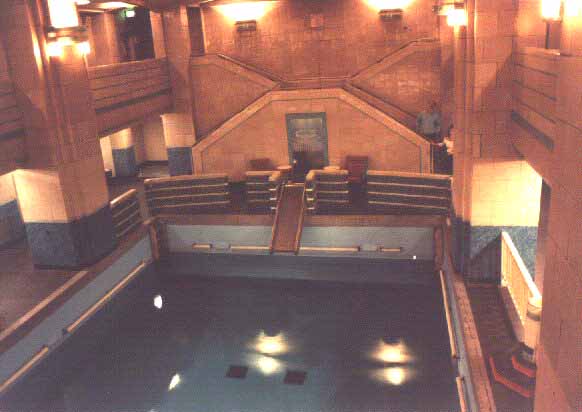
Shots of pool looking aft and forward in the days when it was last filled with water.
Eighteen dressing boxes, with showers and toilets adjacent are provided at the aft end, while a cloakroom is provided at the port side, and an attendants' room at the starboard side. The bath is equipped with two diving boards a chute and four ladders."
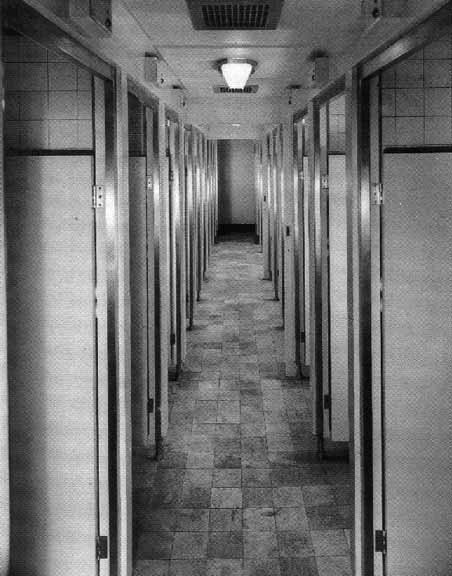
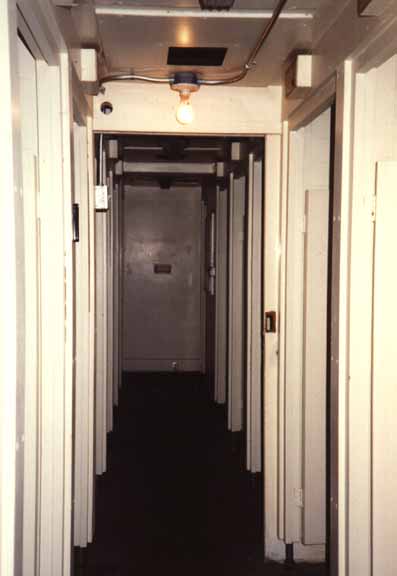
Left - the dressing boxes when they were new, and right, as they are today.
An elegant indirect lighting scheme bathed the whole area in a silver/pearl glow
reflecting light off the cambered mother of pearl ceiling,
The actual depth of the pool basin is about two feet deeper than described above since the
water levels 6 ft. deep, and 4 ft shallow, were set down into the basin to preclude water
overflowing the basis as the ship pitched or rolled in heavy seas.
The Turkish baths were located at the balcony level on the port side of R deck. A
delightful book was recently written by a bathroom steward entitled "I've seen
them all naked."
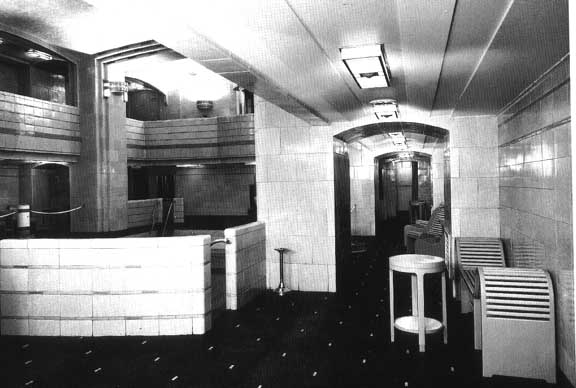
The Turkish baths were on the top left level of this photo which shows the
original furniture for the pool.
1936 - 1939 - The pool was used as a cabin (1st) class facility. The two diving boards
described in the Shipbuilder were removed before the maiden voyage! Apparently someone
realized that when the ship pitched, the water level in the pool could shift dramatically
creating a safety hazard to divers.
Times were set for male bathing (swimming suits optional!), female bathing (swimming suits
required) and mixed bathing.
1940 - 1946
During World War II, the pool was converted to a dormitory space. Layers of bunks were
built into the basin reaching towards the ceiling. The story told aboard the ship today is
that the mother of pearl (or imitation mother of pearl) ceiling pieces were picked loose
for use as poker chips.
1947 - 1967
The pool was restored after World War II to its pre-war glory. The straw-colored tile
facing was replaced, where damaged, with a ceramic facing of very similar color and
texture.
In the post-war period the pool was opened to third class passengers for a designated time
each day. The water was changed after they had used it though.
1968 to present
The immediate pool area itself has
been left largely intact since the Queen Mary arrived in Long Beach. However,
the adjacent Turkish baths were totally gutted for a meeting room that was never
completed. They now serve as a storage area. In the pool area itself the
decorative silvered glass panel of flying birds at the base of the stairs was
destroyed - some say intentionally by an irate workman. It has been replaced by
another glass panel, unfortunately one removed (and not replaced) from the
second class grand staircase.
While the pool has been used as a setting in various motion pictures including
as a scene for a murder in "Someone to Watch Over Me", this fabulous
amenity has not been made available for use to hotel guests at the Queen Mary.
Various reasons have been given including staffing and maintenance costs,
structural integrity and safety.
The conversion of the Queen
Mary's power system from direct to indirect current has affected the performance
of the original lighting system. It was not fully converted in the pool area,
resulting in an under powered lighting system.
The removal of that structural flange beneath the pool area during the gutting
of the ship's power train between 1968 -1971 has resulted in settling and damage
to the pool area. At present, the pool basin is not filled with water because of
this problem.
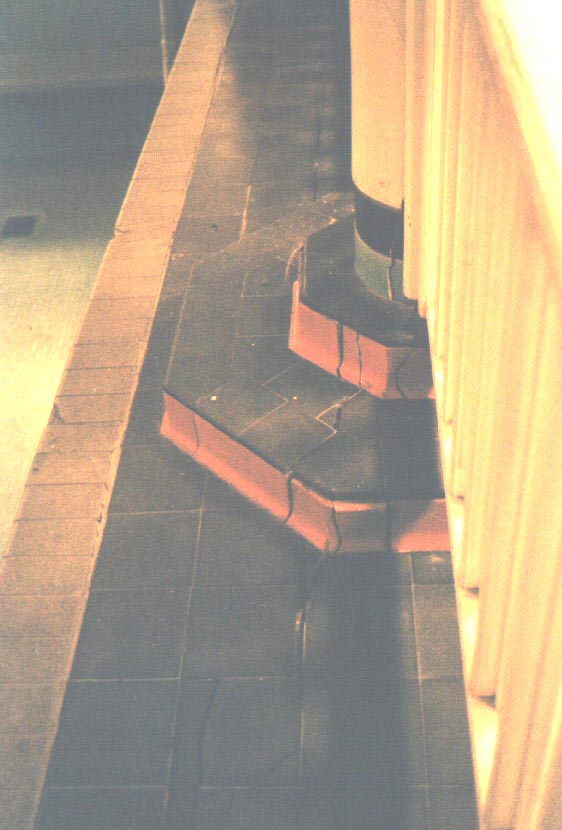
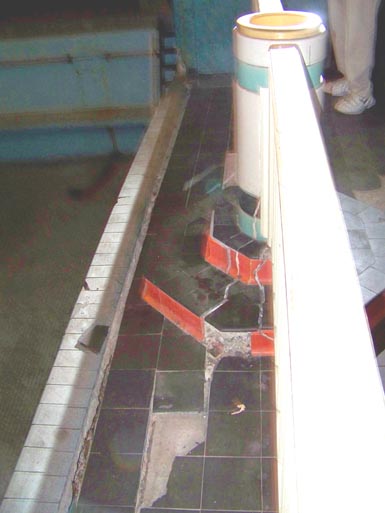
Cracking is evident around the edge of the pool due to settling (1999 - left and 2008 - right).
In 1995 the lessee RMS Foundation, in what would have been a great step toward the ship’s restoration and preservation, announced their intention to restore the pool for hotel guest use and build an exercise area in the adjacent and gutted Turkish bath area. Unfortunately this was never acted upon. Instead, in the year 2000, they installed the ‘Ghosts & Legends’ tour which exploits the pools deteriorating condition. One side of the pool’s tank was fitted with equipment that fills it with fog while the area around the tank on the C Deck level was littered with lighting and special effects equipment.
As the above photos show, nearly ten years of neglect hasn’t been kind to the pool area and the carnival sideshow nature of the ‘Ghosts & Legends’ show puts absolutely no demands on the pool’s maintenance.
Read our detailed article on the ‘Ghosts & Legends’ tour here:
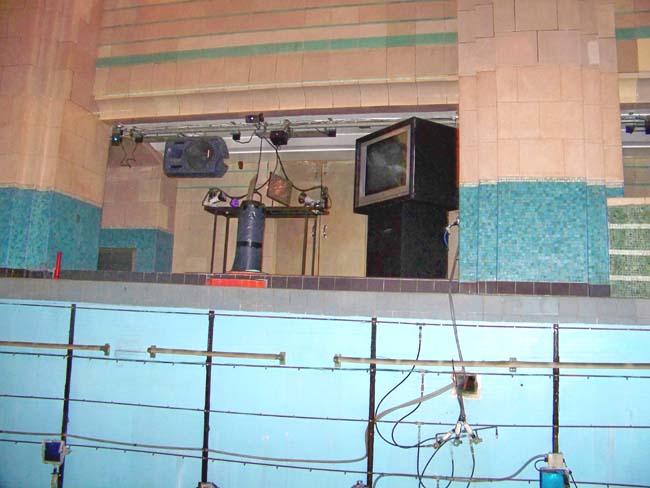
One side of the pool showing some of the lighting and fog making equipment that litters the area.
W. Cwiklo was once
told by the RMS facility manager that the structural problem, a missing
flange, could be corrected for under $10,000. The health and safety issues
include improved lighting, signage, securing of the basin area to prevent
children wandering in while it is unattended, a new filtration system, and
possible adjustments to the basin to adjust the depth of the water and permit
easier egress from the basin. All of these are readily correctable problems.
Finally, state and local safety codes require a four foot clearance around the
perimeter of the pool. The structural columns adjacent to the basin cannot be
moved, but a variance is obtainable, particularly since the Queen Mary is on the
National Register of Historic Places. Foolish ghost stories aside the pool was
used safely over a period of thirty years on the North Atlantic. It can be used
safely in the secure harbor of Long Beach.
The swimming pool remains one of the two most popular tourist attractions on the
ship. (The remaining engine room is the other most popular attraction.) The
guided tours wind their way through this area every 15 to 30 minutes between
10:30 a.m. and 5:30 p.m. This popular use creates a dilemma that perhaps has
retarded the various lessees from proceeding vigorously in restoring the pool
for hotel guest use.
It is unfortunate that the second class pool on original F and G decks (now
called E and F decks) was removed in the conversion.
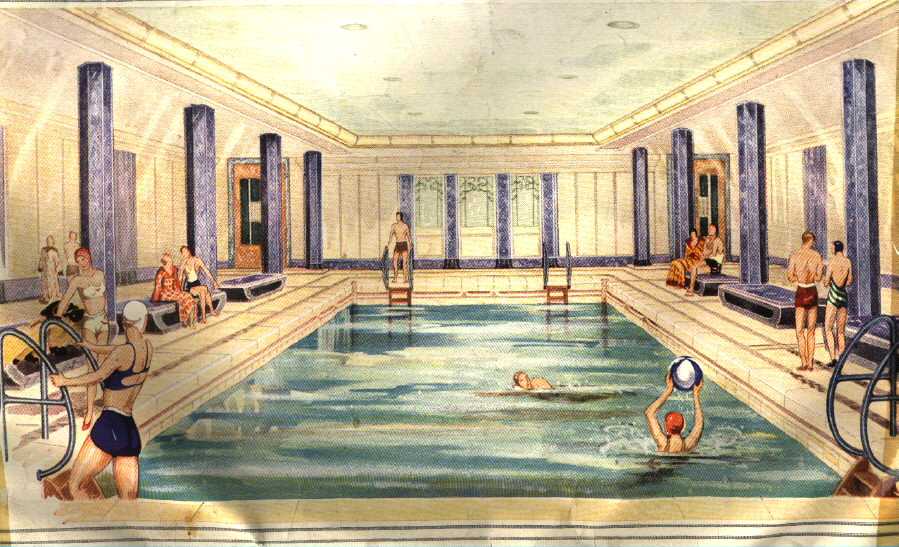
The now destroyed Second Class Pool.
This pool located in the aft of the ship at the base of the second class grand staircase and elevator bank was an elegant facility (with adjacent dressing rooms and a gymnasium), that was perfectly sited for the private enjoyment of hotel guests. If one could turn back the hands of time and correct a foolish error, one might resurrect this lovely pool for the private use of hotel guests while the first class pool is shown on guided tours during the day.
![]() Return to Index by Deck
Return to Index by Deck